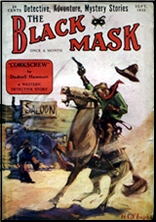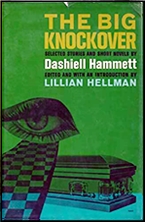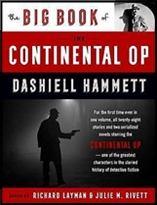Sun 27 Dec 2020
Pulp PI Stories I’m Reading: DASHIELL HAMMETT “Corkscrew.â€
Posted by Steve under Pulp Fiction , Stories I'm Reading[14] Comments

DASHIELL HAMMETT “Corkscrew.†The Continental Op #20. Short novel. First published in The Black Mask, September 1925. Reprinted in Ellery Queen’s Mystery Magazine, September 1947 (severely edited by Fred Dannay). Collected in The Big Knockover, edited by Lillian Hellman (Random House, hardcover, 1966) which includes all of Dannay’s changes and adds one. Also collected in The Big Book of the Continental Op (Vintage Crime/Black Lizard, softcover, 2017), which goes back to the original text and reverses all the changes.
In many ways “Corkscrew†is one of my favorites of Hammett’s shorter works. In it the Op travels to an isolated small town in Arizona (circa 1925, I presume) and tries his best to fit in as an obvious city slicker in one of the last pockets of the Old West, complete with all of the lawless elements you can think of, standard cliches all, including some of the newer ones, such as opium users and human trafficking of would-be immigrants across the border.

Nor did the Old West have automobiles (flivvers) or telephones, although while I’m sure they are mentioned, I don’t think anyone in Corkscrew had one. The Op’s mission is supposed to be a secret: he’s undercover as the new deputy sheriff in town, but he’s recognized as that eve before he arrives. He’s been sent by the head office to clean up all of the bad element so that their clients can come safely in and bring commercial enterprise to the area.
The scene that I like best – and it’s stuck with me ever since I read this story the first time – is the one in which the Op is joshed along by some ranchhands who persuade him that the horse they’re offering to sell him is as gentle a horse as there ever could be. Ha! Three times on, and three times off. The Op is no horseman, but it is a way to get the locals’ respect.

What I also noticed this time around is how much of precursor to Red Harvest this tale is. The Op comes in and when the opportunity arises, he sets one faction of the non-savory aspect of Corkscrew against the other. What I also noticed is this is more than just a crime story. It’s a detective tale as well, and well-clued at that. And I didn’t even notice!
Here’s a link to the long list of changes Fred Dannay made when he published the story in EQMM, as carefully delineated by Terry Zobeck on Don Herron’s website.
Some are relatively minor, some consist of huge chunks of expository text. And some are explainable, sort of. A character referred to as the “the Jew†in the original version becomes “The Toad†in EQMM. It’s not a choice I would have made, but as I said, it sort of makes sense.
December 27th, 2020 at 10:23 pm
The OP got around. I recall one where contemplating a mob during a revolution he notes he can never see a mob without wanting to be on a rooftop with a .50 caliber machine gun.
This one always struck me as being a good basis for the kind of B Western programmer where George O’Brien or Johnny Mack Brown turn out to be less of a city slicker than everyone thinks.
December 27th, 2020 at 10:53 pm
I think either of those two gents could play the Op in the movie they should have made of this one.
December 27th, 2020 at 11:56 pm
Speaking strictly for myself and my own weird taste: once, when I tried to read some of Hammett’s non-trad stories I got stung sharply by ‘Tulip’. It was awful. So awful, that I vowed for ever after, to stay with what I’d already read from him. Even when new Hammett stories turn up (‘Nightmare Town’, etc), I won’t even go near ’em. I’ll just go back and re-read old faves. ‘Tulip’ …augh. One of the worst readings experiences ever.
December 28th, 2020 at 12:23 am
Dear Lazy,
Everything Hammett was republished with the distribution of Julia and Robards’s fine work, but you nailed it. Tulip is Tabu; mustn’t touch. On the other hand, Joe Gores showed well at the time, not so sure now.
December 28th, 2020 at 9:19 am
Fully agreed. As I understand it, “Tulip” was never meant to have been published, not by Hammett, anyway. Nor were his laundry lists. See Dan Stumpf’s review of Selected Letters of Dashiell Hammett, as edited by Richard Layman and Julie Rivett:
https://mysteryfile.com/blog/?p=72000
December 28th, 2020 at 12:24 am
Every time I read about Dannay and his deletions and censorship, I always have the same reaction. Who the hell does he think he is? There is really no excuse for Fred Dannay to have so severely edited Hammett’s work. He did such a terrible job reprinting Hammett that it makes no sense to read the reprints because of the rampant censorship.
I’m against any sort of literary censorship. We are adults and we don’t need dumbing down efforts to protect us as though we are children.
I can take the offensive language. I may not like it but I’m not going to fall out of my chair crying and whining because some character cursed or said a racially offensive word. I just checked and I see that amazon is still selling the Joseph Conrad novel titled “The N-Word of the Narcissus”. Such censorship ruins the novel. The simple fact is that whether we like it or not, tough sailors were not sensitive all the time and quite frequently used offensive labels.
The same thing applies to Hammett’s west. If we don’t like the words we can stop reading. No excuse for censorship at all. Once we start it’s a slippery slope that ends up with massive deletions like Fred Dannay did.
December 28th, 2020 at 9:24 am
I am torn between your point of view, Walker, and the fact that if Dannay hadn’t done what he did, Hammett would have been all but forgotten a whole lot longer. But after seeing the hatchet job he did on “Corkscrew,” you have to wonder whether it was worth it. I do, anyway.
December 28th, 2020 at 11:58 am
This is one of my favorite Op tales too. In addition to its literary strengths well deliniated here by others, I like it because it’s set right here where I live &, believe it or not, the passage of time has only changed details of the setting, not its essence. The story well illustrates how some issues of the US/Mexican border (mainly its porous nature) haven’t changed much in 100 years.
December 28th, 2020 at 3:53 pm
I have kept my word, ordered and received the Selected Letters of Dashiell Hammett. Easy enough to dodge those of little interest, and it is a handsome volume.
December 28th, 2020 at 4:01 pm
Substantially more than Hammett’s laundry lists, then!
December 28th, 2020 at 8:02 pm
Barry, if you will let us know if the letters are substantial enough to wade through the other business. Not every good writer is a good letter writer though I would expect Hammett to be.
I’m curious how much gold there is among the dross.
December 29th, 2020 at 11:20 am
Will do, David, but I have not really started on that.
December 29th, 2020 at 6:08 pm
I just found your website and it’s fantastic. Thanks for writing about the old pulps! cheers from mexico!
February 26th, 2021 at 11:58 am
David, my comments regarding Hammett’s Letters and the book are in the previous post as of last evening.